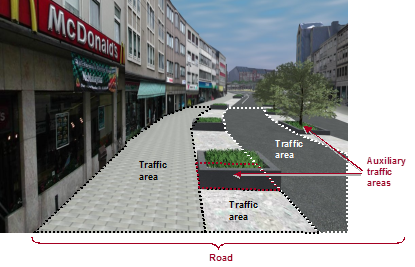2.6.4.8. Transportation Model¶
The transportation model of CityGML is a multi-functional, multi-scale model focusing on thematic and functional as well as geometrical/topological aspects. Transportation features are represented as a linear network in LoD0. Starting from LoD1, all transportation features are geometrically described by 3D surfaces.
The main class is TransportationComplex (cf. Fig. 2.19) which represents, for example, a road, a track, a railway, or a square. It is composed of the parts TrafficArea and AuxiliaryTrafficArea. Fig. 2.18 depicts an example for a LoD2 TransportationComplex configuration within a virtual 3D city model. The Road consists of several TrafficAreas for the sidewalks, road lanes, parking lots, and of AuxiliaryTrafficAreas below the raised flower beds.

Fig. 2.18 LoD2 representation of a transportation complex (from: [GKCN2008])
The road itself is represented as a TransportationComplex, which is further subdivided into TrafficAreas and AuxiliaryTrafficAreas. The TrafficAreas are those elements, which are important in terms of traffic usage, like car driving lanes, pedestrian zones and cycle lanes. The AuxiliaryTrafficAreas are describing further elements of the road, like kerbstones, middle lanes, and green areas.

Fig. 2.19 UML model for transportation complex
TransportationComplex objects can be thematically differentiated using the subclasses Track, Road, Railway, and Square. Every TransportationComplex has the attributes class, function and usage, referencing to the external code lists. The attribute class describes the classification of the object. The attribute function describes the purpose of the object like, for example national motorway, country road, or airport, while the attribute usage can be used, if the actual usage differs from the function.
In addition, both TrafficArea and AuxiliaryTrafficArea may have the attributes class, function, usage, and surfaceMaterial. The attribute class describe the classification of the object. For TrafficArea, the attribute function describes whether the object is a car driving lane, a pedestrian zone, or a cycle lane, while the usage attribute indicates which modes of transportation can use it (e.g. pedestrian, car, tram, roller skates). The attribute surfaceMaterial specifies the type of pavement and may also be used for AuxiliaryTrafficAreas (e.g. asphalt, concrete, gravel, soil, rail, grass etc.). The function attribute of the AuxiliaryTrafficArea defines, among others, kerbstones, middle lanes, or green areas. The possible values are specified in external code lists.
TransportationComplex is a subclass of _TransportationObject and of the root class _CityObject. The geometrical representation of the TransportationComplex varies through the different levels of detail. In the coarsest LoD0, the transportation complexes are modelled by line objects establishing a linear network. Starting from LoD1, a TransportationComplex provides an explicit surface geometry, reflecting the actual shape of the object, not just its centreline. In LoD2 to LoD4, it is further subdivided thematically into TrafficAreas, which are used by transportation, such as cars, trains, public transport, airplanes, bicycles, or pedestrians and in AuxiliaryTrafficAreas, which are of minor importance for transportation purposes, for example road markings, green spaces or flower tubs.